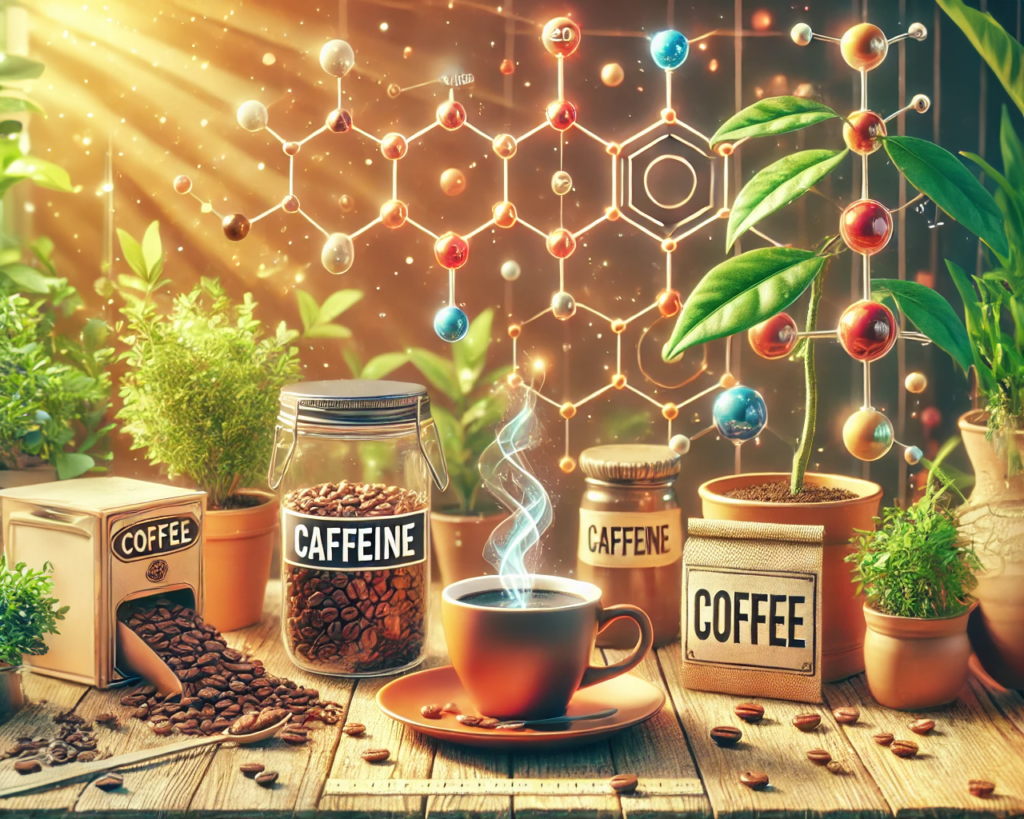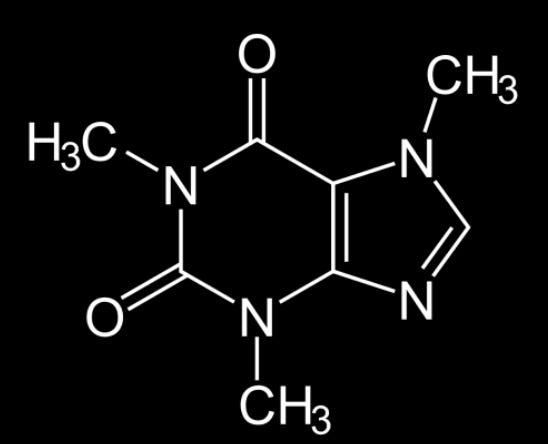
Caffeine is a widely consumed stimulant known for its ability to increase alertness and wakefulness. While caffeine most notably affects the central nervous system, it also impacts various other bodily systems. This article explores the effects of caffeine on the cardiovascular, respiratory, gastrointestinal, renal, and musculoskeletal systems, along with its benefits and potential side effects.
🧐10 interesting facts about caffeine
- ☠️The lethal dose of caffeine is around 10 grams – about 50 cups of coffee (Caffeine toxicity).
- 🌎Caffeine is the most widely used drug in the world. Alcohol is second, and nicotine is third (Alcohol, nicotine, caffeine, and mental disorders).
- 📊 85% of Americans consume caffeine daily (Trends and patterns of caffeine consumption).
- 💉The World Anti-Doping Agency (WADA) had listed caffeine as a banned substance until 2004. After that year, caffeine was removed from the banned list but remained a part of WADA’s monitoring program (Usada – Substance Profile: Caffeine)
- 📈 In 2021, the market size was valued at $715.2 million and is projected to reach $1.2 billion by 2031, growing at a CAGR of 5.2% from 2022 to 2031 (Allied Market Research).
- 🚾Although caffeine is a diuretic (makes you pee), the amount of water in a cup of coffee compensates for the fluid loss and hence, a cup of coffee ends up being a net positive on your fluid status (Caffeine ingestion and fluid balance: a review).
- ⏰The elimination half-life of the caffeine molecule from plasma is between 1.5 and 9.5 hours. Pro tip: no coffee after 12pm if you are susceptible (Pharmacology of Caffeine).
- ☕Decaf coffee is not entirely caffeine-free, it still has ~10mg of caffeine per cup. A cup of regular coffee, on the other hand, has around~200mg.
- 🍫Chocolate has caffeine in it. The darker the chocolate, the higher the caffeine content. (Determination of the caffeine contents of various food items within the Austrian market and validation of a caffeine assessment tool)
- 🧠Coffee can help fight depression. However, overconsumption of caffeine – more than 400 mg per day, has been linked to increased risk of depression (Coffee Consumption and the Risk of Depression in a Middle-Aged Cohort: The SUN Project).
📜A Brief history lesson: Coffee timeline

- 9th Century, Ethiopia: Legend has it that coffee was discovered by a goat herder in Ethiopia who noticed the energizing effects on his goats after they consumed coffee berries.
- 15th Century, Middle East: Coffee was first brewed in the Middle East and became a popular drink among the upper class.
- 17th Century, Europe: Coffee spread to Europe and became a staple beverage. Coffee houses became widespread in England, with thousands opening in London during the late 17th and early 18th centuries.
- More than 4,000 years ago, China: Tea was first consumed in China and later introduced to the Western world in the 16th century.
- 17th Century, England: Tea became a popular beverage in England and a significant part of British culture.
- 1884, United States: The first caffeinated soda, Moxie, was created.
- 17th & 18th Centuries, Global Expansion: As coffee’s popularity grew, coffee plantations were established in tropical regions such as Africa, the Caribbean, and South America, often relying on slave labor for cultivation.
🤣Jocko: “Drinking coffee is weak”
⚗️Chemistry
Caffeine is a naturally occurring stimulant with the chemical formula C8H10N4O2, known scientifically as 1,3,7-trimethylxanthine. The suffix “-ine” in “caffeine” and in many other similar chemical compounds such as nicotINE and cocaINE primarily denotes the substance as an alkaloid. Alkaloids are a broad group of naturally occurring organic compounds that mostly contain basic nitrogen atoms.
Alkaloid compounds are produced by a large variety of organisms including bacteria, fungi, plants, and animals, and are often found in nature as part of plant-derived substances. In the case of caffeine, it is found in coffee beans, tea leaves, and other plants, and it is structurally very closely related to other natural alkaloids like theophylline (found in tea) and theobromine (found in cocoa).
Comparison with Similar Molecules
Caffeine’s close relatives, theobromine and theophylline, share a similar core structure but differ in the number and position of methyl groups. This subtle difference is crucial, as it affects each compound’s potency and effect on the human body. For instance, theobromine is less potent than caffeine and is known for its milder, longer-lasting stimulant effects, while theophylline has a stronger effect on smooth muscle tissue and the respiratory system. This is pretty cool stuff because this is basically how pharmaceutical companies play with the shape of different molecules to see what changes they can generate to alter the strength, efficacy, and duration of various compounds.
Molecular Interactions and Solubility
Caffeine is notable for its solubility in water, which is a key factor in its widespread use in beverages like coffee and tea. This property makes it easily absorbed by the human body, leading to its quick and efficient stimulatory effects.
⚙️How it works
Interaction with Adenosine Receptors
The structure of caffeine is closely related to its ability to stimulate the central nervous system – where caffeine acts as an antagonist at adenosine receptors.
But first, we have to talk about adenosine. Adenosine is a neuromodulator that plays a crucial role in a number of processes – including sleep regulation. Here’s a brief description of how that works:
- Energy Consumption and Adenosine Production: When you’re awake, your neurons are actively working and consuming energy. This energy is primarily derived from adenosine triphosphate (ATP), the primary energy currency of cells. As neurons use ATP, adenosine is left over as a byproduct. Throughout the day, as you continue to consume energy, adenosine levels gradually increase in the brain.
- Adenosine Accumulation and Sleep Pressure: The increasing levels of adenosine in the brain create what my colleagues call “sleep pressure.” Essentially, the longer you’re awake, the more adenosine accumulates, and the more you feel the need to sleep. BTW, sleep is a protective mechanism to ensure that the brain gets the rest it needs to function optimally.
- Adenosine Receptors and Sleep Induction: Adenosine exerts its sleep-inducing effects by binding to specific adenosine receptors in the brain. These receptors are located in areas that regulate wakefulness. When adenosine binds to these receptors, it inhibits neuronal activity, leading to a decrease in arousal and an increase in the tendency to sleep.
- Caffeine and Adenosine: An interesting aspect of adenosine’s role in sleep is its interaction with caffeine. Caffeine works as an adenosine receptor antagonist. It binds to adenosine receptors without activating them, effectively blocking adenosine from binding. This is why caffeine can temporarily ward off sleepiness and increase alertness.
- Sleep and Adenosine Clearance: During sleep, particularly during deep sleep, the body clears adenosine from the brain. This reduction in adenosine levels is partly why you feel refreshed and alert after a good night’s sleep.
In other words, adenosine binds to its receptors and produces a sedative effect. However, when caffeine is consumed, it competes with adenosine and binds to these receptors without activating them. This blockage prevents adenosine from binding and stops it from creating the feeling of tiredness, thus promoting alertness and wakefulness.
Pro-tip: Wait at least 90 minutes after waking up in the morning before your first cup of coffee, otherwise you will crash at around 2pm. This happens because you need to give your body the chance to clear the remaining adenosine from the previous night before you block the receptor. If you don’t wait at least 90min, whenever the effect of your first cup of coffee wears off, the adenosine you didn’t clear because you were inpatient will bind to its receptor and will make you sleepy. 2pm for sure. Right before that meeting.
Other Interactions
While caffeine’s most notable action is as an antagonist to adenosine receptors, caffeine also influences other biochemical pathways:
- Phosphodiesterase Inhibition: Caffeine inhibits phosphodiesterase enzymes, which leads to an increase in intracellular cyclic AMP (cAMP). Elevated cAMP levels enhance various physiological processes, including increased heart rate and lipolysis (fat breakdown).
- Calcium Release: Caffeine affects intracellular calcium release, which can influence muscle contraction and neurotransmitter release.
- Acetylcholine Receptor Modulation: Some studies suggest that caffeine may interact with acetylcholine receptors, though this interaction is less significant compared to its effect on adenosine receptors.
👍🏽Beneficial Effects
Effects on Performance
- Cognitive Function: Results from 13 studies indicate that intake of a low/moderate dose of caffeine before and/or during exercise can improve energy, mood, and cognitive functions, such as attention; it may also improve simple reaction time, choice reaction time, memory, or fatigue. Caffeine and Cognitive Functions in Sports: A Systematic Review and Meta-Analysis. Pareja-Galeano et. al.
- Physical Performance: Caffeine can enhance physical performance by mobilizing fatty acids from fat tissue and increasing adrenaline levels, and increasing muscle contraction, leading to improved physical endurance and stamina. Effect of Caffeine Supplementation on Sports Performance Based on Differences Between Sexes: A Systematic Review. CAlleja-Gonzalez, J et. al.
- Mood Enhancement: Caffeine can act as a mild antidepressant and is linked to a lower risk of depression. This is likely due to its ability to boost neurotransmitter levels, such as dopamine and serotonin, in the brain. Caffeine consumption and self-assessed stress, anxiety, and depression in secondary school childrenGareth Richards and Andrew Smith.
Effects on Longevity
- Reduced Cognitive Decline: Regular, moderate caffeine intake is associated with a reduced risk of cognitive decline and may enhance brain function, potentially contributing to healthier aging. Higher Coffee Consumption Is Associated With Slower Cognitive Decline and Less Cerebral Aβ-Amyloid Accumulation Over 126 Months: Data From the Australian Imaging, Biomarkers, and Lifestyle Study. Martins, RN, et. al.
- Antioxidant Properties: Caffeine contains antioxidants, which help in fighting free radicals in the body. Free radicals are unstable molecules that can cause cellular damage and have been linked to aging and various diseases. Caffeine and Its Antioxidant Properties—It Is All about Dose and Source. Vari, CE, et. al.
- Reduced Risk of Certain Diseases: Several studies suggest that caffeine intake is associated with a lower risk of certain diseases, including Parkinson’s disease, Alzheimer’s disease, and certain types of cancer. Caffeine as a protective factor in dementia and Alzheimer’s disease. Marjo H Eskelinen, Miia Kivipelto and Health Benefits of Coffee Consumption for Cancer and Other Diseases and Mechanisms of Action. Chapkin, RS, et. al.
- Heart Health: Moderate caffeine consumption may be linked to a lower risk of heart disease in some individuals. However, this can vary depending on individual health conditions and should be monitored. Impact of Coffee Consumption on Cardiovascular Health. Lavie CJ, et. al.
- Type 2 Diabetes: Research indicates that caffeine may reduce the risk of developing type 2 diabetes. This could be due to its potential to improve insulin sensitivity or reduce chronic inflammation. Coffee consumption and reduced risk of developing type 2 diabetes: a systematic review with meta-analysis. Mattias Carlström, Susanna C Larsson
- Liver Protection: Caffeine has been associated with a lower risk of liver disease, including liver fibrosis and cirrhosis. Coffee: The magical bean for liver diseases. Tahan, V, et. al.
- Metabolic Rate: Caffeine can increase the metabolic rate in the short term, potentially contributing to weight management and reduced risk of obesity, a major risk factor for many chronic diseases. Comparison of changes in energy expenditure and body temperatures after caffeine consumptionP Koot 1, P Deurenberg
- Longevity: Some studies suggest a correlation between moderate caffeine consumption and increased overall lifespan, possibly due to the combined effects of the above benefits. Coffee for Cardioprotection and Longevity. James H O’Keefe, James J DiNicolantonio, Carl J LavieThanks for reading Level Up! Subscribe for free to receive new posts.Subscribed
👎🏽Side effects
Caffeine, while beneficial in moderate amounts, can lead to several negative side effects, especially when consumed in high doses. Here are some of the common negative side effects associated with excessive caffeine intake:
- Insomnia: Caffeine can interfere with your sleep cycle, leading to difficulty falling asleep or staying asleep. This is particularly true if consumed in the late afternoon or evening. I drink my last cup of coffee after lunch. Caffeine consumption, insomnia, and sleep duration: Results from a nationally representative sample. Chakravorty, S et. al.
- Anxiety: High doses of caffeine can lead to increased anxiety, nervousness, and even panic attacks in sensitive individuals. Effects of caffeine on anxiety and panic attacks in patients with panic disorder: A systematic review and meta-analysis. Lisa Klevebrant, Andreas Frick
- Digestive Issues: Caffeine stimulates acid production in the stomach, which can lead to gastrointestinal discomfort, acid reflux, or heartburn in some individuals. Effects of Coffee on the Gastro-Intestinal Tract: A Narrative Review and Literature Update Astrid Nehlig
- Increased Heart Rate: Overconsumption of caffeine can cause a noticeable increase in heart rate (tachycardia) or palpitations, which can be concerning for those with certain heart conditions. Coffee Consumption and Incident Tachyarrhythmias: Reported Behavior, Mendelian Randomization, and Their Interactions. Marcus, GM et. al.
- High Blood Pressure: Temporary increases in blood pressure are common after consuming caffeine, which can be a concern for individuals with hypertension or at risk for heart disease – If you have high blood pressure do me a favor and get it under control. We have meds for that. It will kill you. Coffee Consumption and Blood Pressure: Results of the Second Wave of the Cognition of Older People, Education, Recreational Activities, Nutrition, Comorbidities, and Functional Capacity Studies (COPERNICUS)
- Dependency: Regular consumption of caffeine can lead to physical dependence, and withdrawal symptoms can occur if you suddenly stop consuming it. These symptoms may include headache, fatigue, irritability, and difficulty concentrating – If I skip my coffee I will absolutely get a head ache 100% of the time. Evaluating Dependence Criteria for Caffeine. Catherine L.W. Striley, Roland R. Griffiths, and Linda B. Cottler
- Muscle Tremors: High doses of caffeine can lead to fine muscle tremors or shakiness. Caffeine and tremor. W Koller, S Cone, G Herbster
- Osteoporosis: This one is controversial. There is some evidence suggesting that high caffeine intake may interfere with calcium absorption and contribute to bone thinning (osteoporosis), especially in individuals with low calcium intake. But there are also some studies indicating that caffeine may be beneficial for bone health due to its high polyphenols composition. I don’t think we understand this one well quite yet. Reply on “Coffee consumption and bone health: A risk assessment” R. Coronado-Zarco
- Fertility Issues: Excessive caffeine consumption has been linked to reduced fertility in some studies, though the evidence is not conclusive. Relationship between caffeine intake and infertility: a systematic review of controlled clinical studies. Hui-Juan Cao, et. al.
- Increased Risk of Heart Attacks among Young Adults: A few studies suggest that very high doses of caffeine may increase the risk of heart attacks among young adults with mild hypertension. Impact of Coffee Consumption on Cardiovascular Health. Lavie, CJ, et. al.
- Mental Health Effects: For some individuals, particularly those with certain mental health conditions, high caffeine intake may exacerbate symptoms like anxiety and mood swings. Caffeine Consumption and Depression, Anxiety, and Stress Levels Among University Students in Medina: A Cross-Sectional Study. Alder, JR, et. al.
🔍Caffeine-Containing Items
- Coffee, brewed – 95-165 mg per 8 oz
- Espresso – 47-64 mg per 1 oz
- Tea, black – 25-48 mg per 8 oz
- Tea, green – 25-29 mg per 8 oz
- Soft drinks (Cola) – 24-46 mg per 8 oz
- Energy drinks – 50-160 mg per 8 oz
- Dark chocolate – 12-25 mg per 1 oz
- Milk chocolate – 3-6 mg per 1 oz
- Decaf coffee – 2-5 mg per 8 oz
- Tea, white – 15-30 mg per 8 oz
- Tea, oolong – 29-53 mg per 8 oz
- Yerba mate – 85 mg per 8 oz
- Matcha tea – 70 mg per 8 oz
- Guarana – 47 mg per 1 gram (used in energy drinks and supplements)
- Chocolate-flavored cereals – Varies, but generally around 3-5 mg per serving
- Instant coffee – 30-90 mg per 8 oz
- Non-cola sodas (like Mountain Dew) – 20-55 mg per 8 oz
- Iced tea (bottled) – 5-40 mg per 8 oz
- Chocolate milk – 2-7 mg per 8 oz
- Chocolate cake or brownies – Varies, but generally around 10-60 mg per serving
Disclaimer: This content is provided for educational purposes only and should not be construed as medical advice. Always consult with your primary care physician (PCP) or a qualified healthcare professional before making any changes to your lifestyle, diet, or exercise routine. The information presented in this article is not intended to diagnose, treat, cure, or prevent any disease. Individual results may vary. The author and publisher of this article are not responsible for any adverse effects or consequences resulting from the use or application of the information provided. Please use your own discretion and judgment when implementing any suggestions or recommendations.





